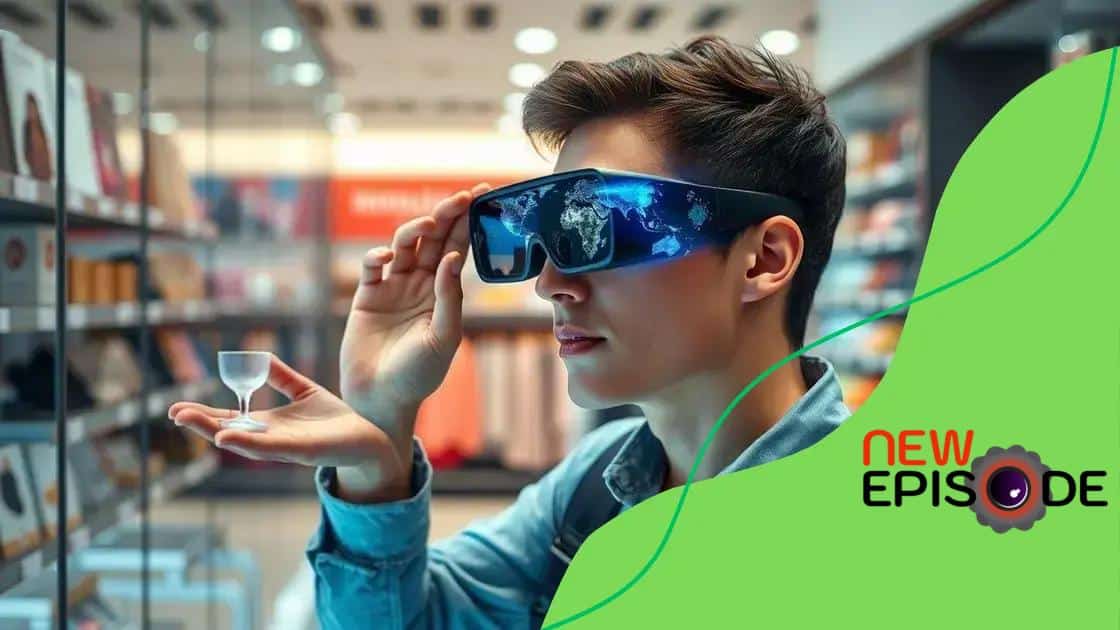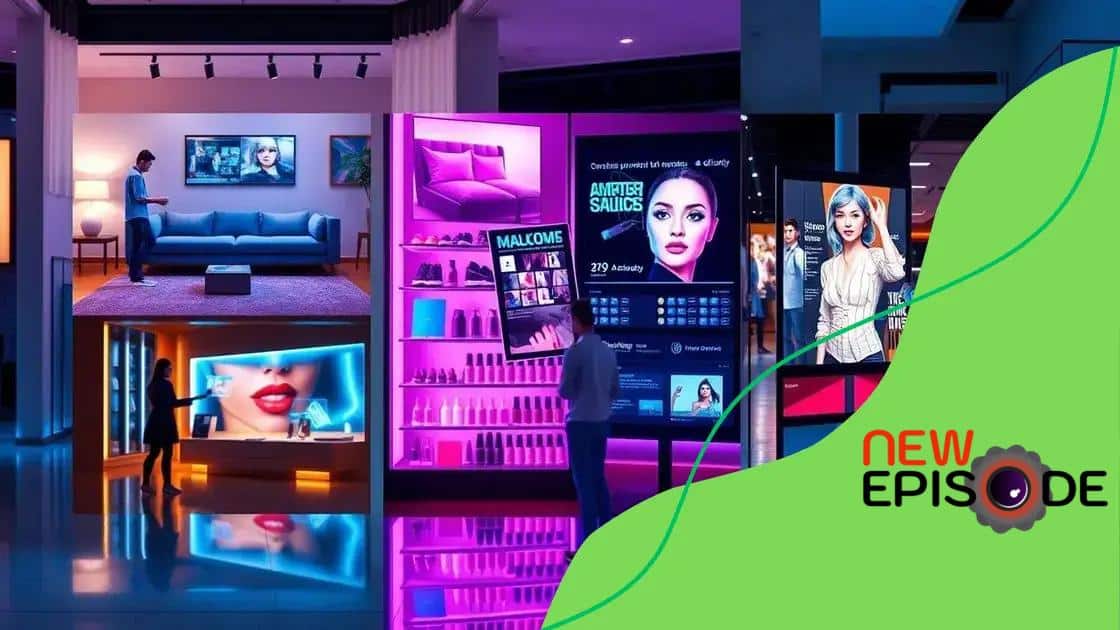How augmented reality is improving customer experiences

Augmented reality is transforming customer experiences by enhancing engagement, enabling personalized interactions, and providing innovative solutions that address challenges such as high costs and user adoption.
How augmented reality is improving customer experiences is a question that many businesses are asking today. With technology rapidly evolving, AR offers unique ways to connect with consumers, enhance shopping, and create memorable interactions. Ready to explore this exciting innovation?
Understanding augmented reality technology
Understanding augmented reality technology is crucial for businesses looking to enhance their customer experiences. Augmented reality (AR) combines the real world with digital content, creating experiences that can be interactive and immersive.
How AR Works
AR uses devices, like smartphones or AR glasses, to overlay digital information onto the physical environment. This technology relies on advanced sensors, computer vision, and software to recognize surroundings and provide relevant content to users. For example, when someone points their phone camera at a product, AR can display reviews, details, or even models of how it would look in a home.
Benefits of Augmented Reality
- Enhanced customer engagement through interactive content.
- Increased conversion rates by allowing customers to visualize products.
- Improved customer satisfaction by providing personalized experiences.
With AR, businesses can provide an engaging shopping experience that can lead to higher sales. Imagine browsing furniture online and being able to visualize it in your living room before making a purchase. This is just one way AR changes how customers shop.
Applications of AR in Business
Many industries are implementing augmented reality to improve their services. Retailers are using AR for virtual try-ons, allowing customers to see how clothes fit without leaving their homes. In real estate, AR lets potential buyers take virtual tours of properties. Even in healthcare, AR assists in surgeries by overlaying important information during procedures.
The use of AR is growing quickly, and businesses that adopt this technology early can set themselves apart in their market. By understanding how augmented reality fits into their strategy, companies can create memorable experiences that delight their customers.
How businesses are leveraging AR to engage customers
How businesses are leveraging AR to engage customers is a growing area of interest. Augmented reality provides innovative ways for companies to interact with their audience, enhancing engagement and creating memorable experiences.
Interactive Experiences
Many brands use AR to create interactive experiences that draw customers in. For instance, customers can scan products in stores to access additional info, videos, or even animated graphics. This type of interactivity increases interest and often encourages purchases.
Gamification of Shopping
Another approach is the gamification of shopping. Brands can create AR games that offer rewards, discounts, or exclusive content. Customers can engage with these games in-store or online, making the shopping experience more enjoyable. For example, a toy company might let users hunt for virtual characters in their store using AR.
Additionally, personalized experiences through augmented reality have been effective. Businesses can use customer data to tailor AR content to individual preferences. This personalization can significantly improve customer satisfaction and loyalty.
Real-Time Feedback
AR also allows for real-time feedback on products. Customers can see how items look and fit in their environment before buying. For instance, a furniture store could enable users to visualize how a couch would look in their living room using AR technology. This feature reduces hesitation and boosts confidence in purchasing decisions.
By integrating AR into their marketing and sales strategies, businesses can foster deeper connections with customers. As technology continues to advance, those who effectively utilize AR will likely gain a competitive edge in their industries.
Case studies of successful AR implementations

Case studies of successful AR implementations show how effective augmented reality can be in various industries. These examples highlight how businesses improve customer engagement, enhance experience, and increase sales.
1. IKEA Place
IKEA launched the IKEA Place app, allowing customers to visualize furniture in their homes before purchasing. Users can use their phones to scan a room and place virtual furniture, checking the fit and style. This interactive experience has boosted customer confidence and reduced returns.
2. L’Oreal Virtual Try-On
L’Oreal has successfully used AR in their virtual try-on feature, enabling customers to see how different makeup products look on their faces. This tool not only engages consumers but also helps them find the right products while shopping online, leading to increased sales for the brand.
3. Adidas AR Experience
Adidas developed an AR feature in their app that allows users to view their shoe selections in real life. By pointing the camera at their feet, customers can see how the shoes look before deciding to buy. This innovation has driven more traffic to their website and attracted younger consumers.
These case studies demonstrate that when businesses leverage augmented reality effectively, they can create unique experiences that resonate with customers. By adopting technology that meets consumer needs, brands can stay ahead in a competitive market.
The future of augmented reality in customer experiences
The future of augmented reality in customer experiences is bright and full of potential. As technology evolves, augmented reality (AR) will continue to transform how customers interact with brands.
Seamless Integration
In the coming years, AR will be seamlessly integrated into everyday life. Imagine shopping where AR features are available through all devices, from smartphones to smart glasses. This will make the shopping experience more intuitive and convenient for users.
Improved Personalization
As data collection improves, the personalization of AR experiences will become more refined. Businesses will harness this data to create customized AR content. Customers could receive tailored recommendations, promotions, and interactive content based on their preferences and behaviors.
Enhanced Virtual Interactions
Future AR will enable enhanced virtual interactions, allowing customers to engage with products and services in new ways. For instance, customers could attend virtual events or shows using AR, seeing product demonstrations and engaging with representatives in real time.
- Virtual reality experiences alongside AR for immersive branding.
- Brand partnerships with AR developers to create unique solutions.
- Increased accessibility for disabled consumers through AR tools.
Advancements in AR hardware will also influence customer experiences. As devices become more affordable and user-friendly, more people will adopt AR technology. This growing adoption will encourage brands to explore innovative applications of AR.
Businesses that embrace AR now will likely lead in shaping the future of customer interactions. By prioritizing augmented reality, companies can connect with consumers in a memorable way, leading to lasting loyalty.
Challenges in adopting augmented reality solutions
Challenges in adopting augmented reality (AR) solutions can hinder businesses from fully benefiting from this technology. While AR offers exciting opportunities, it also presents obstacles that need to be addressed.
1. High Implementation Costs
One significant challenge is the high cost associated with developing and implementing AR applications. Businesses often face expenses related to software development, hardware, and ongoing maintenance. This can be a barrier, especially for small companies with limited budgets.
2. Technical Limitations
Another hurdle is the current technical limitations of AR. Not all devices support high-quality AR experiences, affecting the user experience. Businesses must ensure that their customers have access to the right technology to benefit from AR features. Additionally, creating content that works seamlessly on various platforms can be complicated.
3. User Adoption
User adoption is crucial for the success of AR solutions. People may be hesitant to use new technologies, particularly if they are unfamiliar with how AR works. Businesses must invest in training and education to help users understand and embrace AR, ensuring a smoother transition to new experiences.
- Providing thorough user guides to familiarize customers with AR features.
- Engaging users through effective marketing strategies to drive interest.
- Gathering feedback from users to improve the AR experience.
Furthermore, privacy and security concerns can also impact the adoption of AR solutions. Users may be cautious about how their data is collected and used, which can create mistrust. Businesses must prioritize transparency and security in their AR implementations to alleviate these concerns.
Ultimately, while there are challenges in adopting augmented reality solutions, addressing these issues effectively can pave the way for successful implementation and user engagement.
FAQ – Frequently Asked Questions about Augmented Reality in Customer Experiences
What is augmented reality and how does it work?
Augmented reality (AR) enhances the real world with digital content, allowing users to interact with virtual elements through screens or devices.
What are some benefits of using AR for businesses?
AR can increase customer engagement, improve shopping experiences, and boost sales by providing interactive and personalized content.
What challenges do businesses face when adopting AR solutions?
Common challenges include high implementation costs, technical limitations, user adoption barriers, and privacy concerns.
How can businesses encourage users to adopt AR technology?
Providing training, clear instructions, and engaging marketing strategies can help customers understand and embrace AR features.






